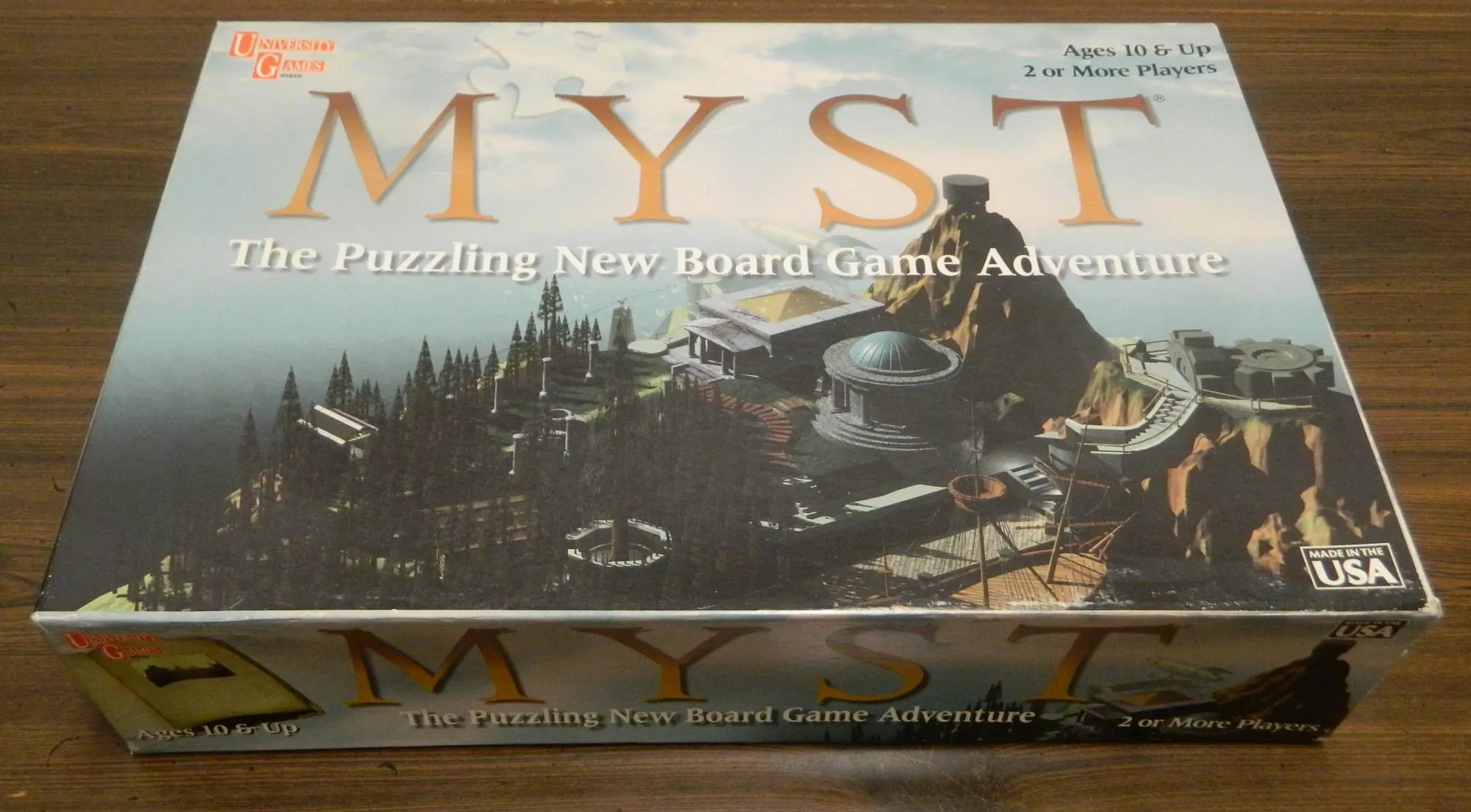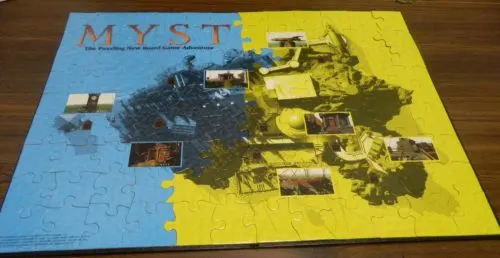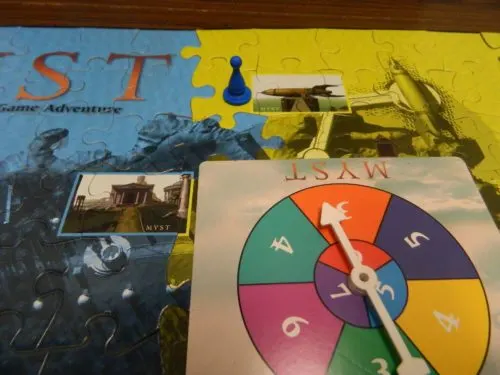Originally created in 1993, Myst began life as a PC puzzle adventure game. Myst was a wildly successful game that was one of the best selling PC games of all time for quite a few years. The game even spawned several sequels. With how popular the PC game was it is not surprising that the game was eventually adapted into a board game. Created in 1998 by University Games, the Myst Board Game tried to adapt the video game into a board game. How exactly do you turn a puzzle adventure game into a board game you may ask? Why you create a board game that utilizes a jigsaw puzzle of course. While the idea of making a jigsaw puzzle board game might not sound that interesting to some people, I have always thought this was an interesting idea for a board game. We have looked at Connect With Pieces in the past and unfortunately it did a poor job implementing a jigsaw puzzle into a board game. The Myst board game actually has some interesting ideas with the jigsaw puzzle mechanics but the lack of real gameplay ruins the experience.
How to Play Myst
Setup
- The players divide into two teams. Each team takes one of the sets of puzzle pieces and the corresponding playing piece.
- Shuffle the cards and deal five cards face down to each team.
- Place the gameboard between the two teams.
Building the Puzzle
Each team looks at the cards that they were dealt. Each team will chose one of their cards that features one of the landmarks. Both teams will reveal their choice at the same time. If both teams chose the same landmark, the team with the youngest player gets to use that landmark and the other team has to choose a different landmark. Each team then finds their puzzle piece that matches the landmark they chose and places it on the corresponding spot on the gameboard.
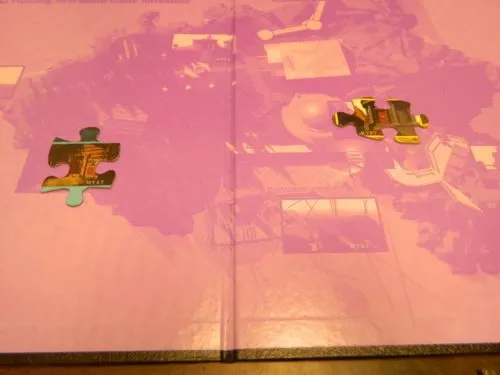
Each team has placed their first pieces on the board. Each team will begin building the puzzle out from their first pieces.
Once both players have placed their first piece on the gameboard, the puzzle phase of the game begins. Both teams will start building the puzzle at the same time. Each team can only play a piece if it connects to another one of their pieces that they have already placed on the board. Pieces should be placed on the board so the picture on the piece matches the part of the board that it is placed on.
While placing pieces a team may eventually get into a situation where they can no longer play any more pieces because their pieces have been surrounded by the other team’s pieces. If the team has a card that features a book, they can play the card to add a piece to any corresponding unoccupied space on the board.

If one of the teams can no longer play any more puzzle pieces, they can use this book card to start building onto a different section of the puzzle.
The players continue building the puzzle until all of the pieces have been added to complete the puzzle. Players then move onto the exploration phase of the game.
Exploration Phase
The youngest player starts the exploration phase by spinning the spinner. The inner number that the spinner stops on will indicate the number of rounds that will be played in the exploration phase. Each team places their marker on the first piece they played to the board.
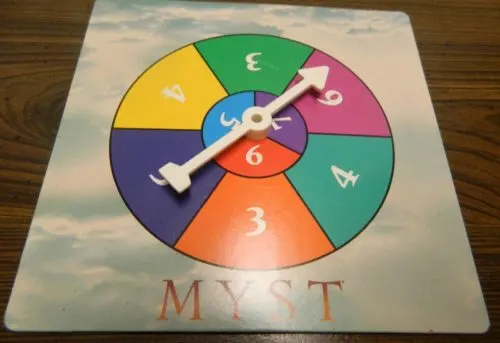
The spinner has been spun to determine the number of rounds. The spinner has stopped on seven (on the inside ring) so seven rounds will be played.
The team that played the least pieces will get to start the exploration phase. The team spins the spinner and gets to move their playing piece up to the number of spaces spun (the outside ring of the spinner). Each puzzle piece counts as one space. A team can choose not to move all of the spaces spun but has to move at least one space.
The other team then spins and moves their piece. A team is unable to move their piece onto a space occupied by the other team. The teams take turns moving until all of the rounds have been completed. The game then moves onto the scoring phase.
If a team has a book card, they can use it to move their playing piece to any space on the puzzle. They can play the card before or after they have moved in a round.
While moving if a team lands on one of the landmark pieces that the other team placed, they can place their own landmark piece on top of the piece that was placed to indicate that they now control the landmark.
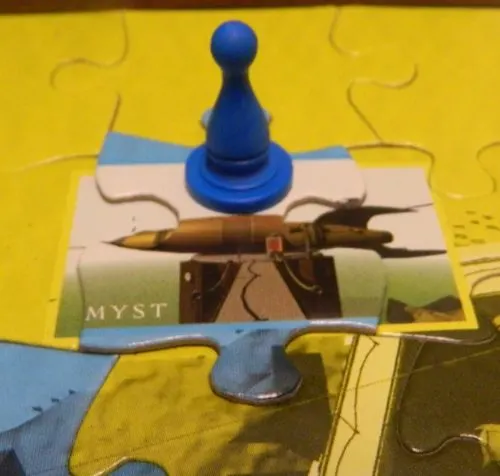
The blue player has landed on a landmark placed by the yellow team. They capture the landmark by placing their own piece on the puzzle.
If the other team then lands on the same landmark they can remove the puzzle piece to indicate that they have regained control over that landmark. That puzzle piece is then removed for the rest of the game.
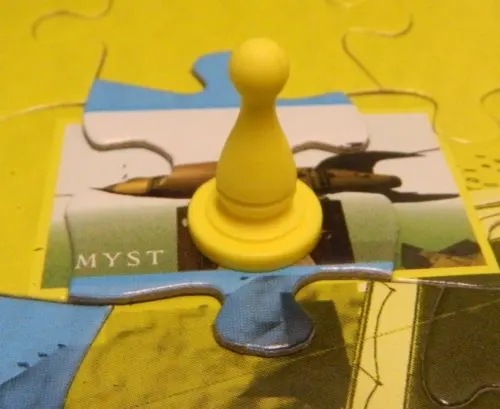
The yellow team has moved back to one of their landmarks that was stolen by the blue team. The yellow team has reclaimed this landmark and the blue puzzle piece is removed from the game.
Scoring
The scoring phase begins with each team counting up how many “marker switches” they added to the puzzle. Each team scores one point for each marker switch that they played.
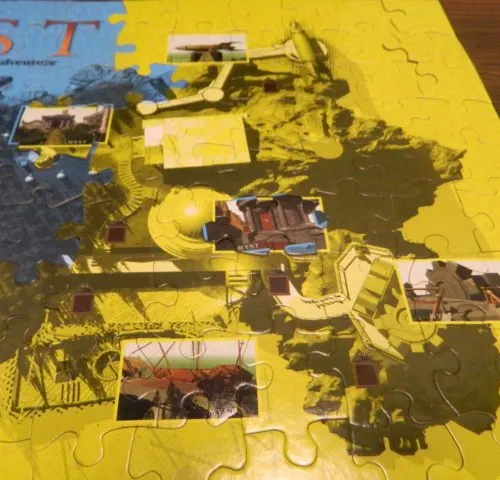
The yellow team has five markers in the area of the puzzle they completed. They will score five points for the markers.
Each team will then consult their landmark cards to see how many additional points they scored. On each landmark card there are two different point values printed. If a team controls a landmark at the end of the game they will receive the “Value” points printed on the card. If the team controls a landmark and was the team that originally placed the puzzle piece, they will also receive the “Bonus” points.
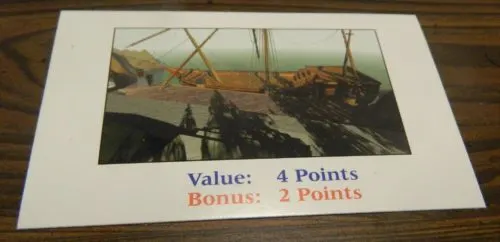
For this card if the team controls the ship they will receive four points. If they also originally placed the puzzle piece they will score two bonus points.
If a team controls more than one card for a landmark they will score the points from all of the cards.
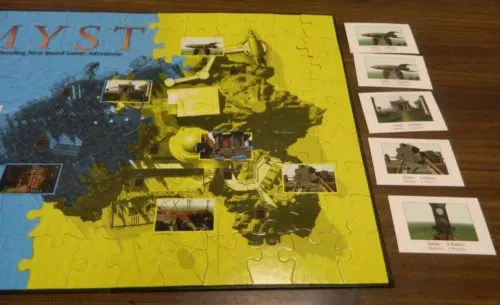
For the rocket ship the player will score five points from the top card and seven points from the second card. The player will score four points for the third card since they won’t get the bonus because they didn’t originally place the piece. For the fourth card they will score five points. They don’t control the landmark on the fifth card so they won’t score any points for that card.
The team that scores the most points wins the game.
My Thoughts on Myst
I would like to begin by saying that I have never played the original Myst PC game. I want to point this out because most people that are interested in the game are probably only interested because they liked the PC game. Having no experience with the PC game though I am going to be looking at the board game without any preconceived feelings about the franchise. It ultimately doesn’t really matter as the board game has very little in common with the PC game. The only thing the board game has in common with the PC game is that the board game uses images and the map from the PC game.
Before playing the Myst board game I have to admit that I was surprisingly intrigued by the game. As I already mentioned I have been looking for a competitive jigsaw puzzle game for a while. I really think the idea of a competitive jigsaw puzzle could make for a really interesting game. While I had a lot of concerns about the Myst board game, I was cautiously optimistic about the puzzle aspect of the game. The puzzle mechanic may have some flaws but it is by far the best part of the game.
If I had to describe the puzzle aspect of the game I would basically call it a competitive jigsaw puzzle. Basically two teams compete try to place the most pieces in a puzzle that both teams share. Both teams are given a set of the same puzzle pieces. Each team gets to start at a different part of the puzzle which they have to build out from. When placing pieces each team tries to build around the other team to block them from playing additional pieces. Players continue to add pieces to the puzzle until the puzzle is completed.
This mechanic might sound really simple but I was surprised by how much I actually enjoyed it. It was surprisingly tense trying to place as many pieces as possible while the other team was trying to do the same. Having both teams compete on the same puzzle really added to the competitiveness. If each team would have just put together their own puzzle it would have just felt like a time trial. With both teams using the same puzzle the teams have to compete to be able to place pieces in the puzzle. While the mechanic is not going to appeal to people who don’t care about jigsaw puzzles, I actually think it makes for a fun competitive jigsaw puzzle.
I think the thing I like the most about the puzzle mechanic is the area control aspect. If the game just had players add pieces anywhere they wanted on the puzzle, it would be kind of chaotic and there would be pretty much no strategy to the game. Myst forces you to add pieces next to pieces you have already placed though. This is actually a really intriguing mechanic as with each piece you add you expand the areas where you can place future pieces. The area control aspect really comes into play as you try to block the other team from areas of the puzzle. This actually added more strategy to the game than I was expecting as I was consciously trying to expand the puzzles in ways where I could cut off the other team.
If I could stop my review at this point I would say the Myst board game is actually a pretty good game. I was genuinely surprised by how much I enjoyed the competitive puzzle mechanics. I think these mechanics are strong enough that I think they could form the basis for a great board game. I would really like to play a board game that expanded on this area control jigsaw puzzle mechanic. The problem with the Myst board game though is that this intriguing mechanic is wasted.
The biggest problem with the game is the exploration mechanic. This mechanic feels like the designers felt that the game needed another mechanic and just decided to add the first thing that came to their mind. Basically in the exploration phase you just spin the spinner and move your playing piece around the gameboard. The only point to this entire mechanic is to give the teams an opportunity to steal landmarks from the other team. It basically just lengthens the game and adds more luck to the game. Before playing the game I thought this mechanic was going to be terrible and my first impression was right.
The main reason why I don’t like the mechanic is that it just feels unnecessary. I see one of two things happening in the exploration phase. If both teams control a similar number of the landmarks the exploration mechanic adds quite a bit of luck to the game. The team that spins better will be able to visit more of the other team’s landmarks while also protecting their own. This will usually lead to the luckier team winning the game. Things might even be worse if one team controls most of the landmarks. In this case the team that controls most of the landmarks will just follow the other team around the gameboard and undo everything that the other team does. In this situation one of the teams may be able to capture at most one or two landmarks which is unlikely to make any difference in who ultimately wins the game.
The problems go further than the exploration phase though. The puzzle itself has its own problems. I would say about half of the puzzle’s pieces are totally pointless. Basically all of the pieces that don’t make up the island itself have no impact on the actual game. Outside of giving the players more options of where they can place pieces, these outer pieces serve no purpose. Since they are worthless both teams are basically going to try to take all of the pieces that make up the island before they even begin to think about placing the water pieces. Then once all of the land has been claimed there really is no reason to complete the rest of the puzzle. Thus the players are forced to finish up the puzzle despite it not making any real difference in the game.
While Myst might support 2+ players, I would probably not recommend more than four players. The game can support more but it will lead to a lot of troubles. The problem is that everyone is working on the same puzzle. With more than two players on each team working on the puzzle, the players will mostly just get in each other’s way.
I also believe that Myst has very limited replay value. As the game only includes one puzzle, I can’t see the game being enjoyable for more than a couple games. I hope you enjoy putting together a puzzle of Myst island because every time you play the game you will have to use the same puzzle. Unless you for some reason like putting the same puzzle together over and over again, I see the game getting repetitive quickly. As the puzzle mechanic is the only thing that saves the game, as soon as that gets repetitive the rest of the game will go with it.
The components could also have used some additional work. I will give the game credit because the puzzle is larger than I expected it to be. The puzzle actually contains 108 pieces. While 108 pieces is not a large puzzle I expected it to be quite a bit smaller. The problem is that the game only includes the one puzzle. I knew the game wasn’t going to include a bunch of puzzles but I would have appreciated two or three puzzles to add a little variety to the game. Otherwise the components are pretty typical of a University Games board game. While fans of the PC game may enjoy the artwork, it kind of looks like the board game just took screenshots from the PC game for its’ artwork.
Should You Buy Myst?
The Myst board game just feels like a waste. The board game has little to do with the PC game outside of the artwork. Myst actually has a really interesting puzzle mechanic and yet doesn’t do nearly enough with it. I actually really liked the competitive jigsaw puzzle mechanic as it is surprisingly tense as both teams fight for control over the puzzle. The fact that you could try to block off your opponent even adds some strategy to the game. This mechanic is compelling enough that I think it has the makings of a good board game. The problem is that Myst wastes the mechanic. Too many of the pieces in the puzzle are worthless and the game gets really repetitive once you have put the puzzle together a couple times. An even bigger problem though might be the exploration mechanic. The mechanic just wastes your time and adds luck to the game.
Basically I have a hard time recommending the Myst board game. If you don’t love Myst or jigsaw puzzles I think you will hate the game. While the game has little to do with the PC game, fans of the series may be able to get a little enjoyment out of the game. If you are interested in a competitive jigsaw puzzle you might also get some enjoyment out of the game even though the rest of the game is extremely flawed. If you are a fan of the PC game or jigsaw puzzles the Myst board game may be worth a couple dollars but otherwise I would pass.
If you would like to purchase the Myst board game you can find it online: Amazon, eBay

